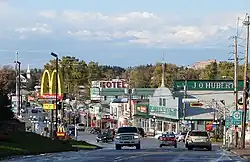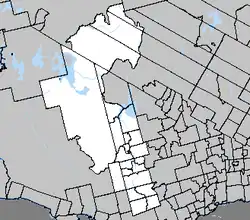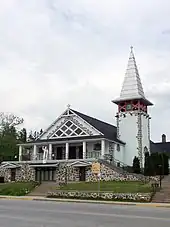Maniwaki
Maniwaki is a town in the province of Quebec, Canada. It is situated 130 kilometres (81 mi) north of Ottawa, Ontario,[4] on the Gatineau River, at the crossroads of Route 105 and Route 107, near Route 117 (Trans-Canada Highway). The town is the administrative centre for La Vallée-de-la-Gatineau Regional County Municipality.
Maniwaki | |
|---|---|
 Main street (Hwy. 105) | |
 Location within La Vallée-de-la-Gatineau RCM | |
 Maniwaki Location in western Quebec | |
| Coordinates: 46°22′30″N 75°58′0″W[1] | |
| Country | Canada |
| Province | Quebec |
| Region | Outaouais |
| RCM | La Vallée-de-la-Gatineau |
| Constituted | March 15, 1904 |
| Government | |
| • Mayor | Francine Fortin |
| • Federal riding | Pontiac |
| • Prov. riding | Gatineau |
| Area | |
| • Total | 8.82 km2 (3.41 sq mi) |
| • Land | 5.67 km2 (2.19 sq mi) |
| Population (2021)[3] | |
| • Total | 3,757 |
| • Density | 662.8/km2 (1,717/sq mi) |
| • Pop (2016–21) | |
| • Dwellings | 2,110 |
| Time zone | UTC−5 (EST) |
| • Summer (DST) | UTC−4 (EDT) |
| Postal code(s) | |
| Area code | 819 |
| Website | www |
History
The history of Maniwaki is closely linked to that of the adjacent Kitigan Zibi Reserve, because the Town of Maniwaki was developed on land that was originally part of this reserve. Its municipal lands were included in historical land claims by Kitigan Zibi; some of which were settled as recently as 2007.[5]
In the first half of the nineteenth century, Algonquins of the mission at Lake of Two Mountains, under the leadership of Chief Pakinawatik, came to the area of the Désert River. Shortly after, in 1832, the Hudson's Bay Company followed them and installed a trading post at the confluence of the Désert and Gatineau rivers. A decade later, Missionary Oblates of Mary Immaculate established the mission of Notre-Dame-du-Desert and, from 1849, they demanded of the authorities the demarcation of a township in order to establish a reserve for the Algonquins. The township limits were drawn in 1850 and the settlement was given the name of Maniwaki by the Oblates at this time (Algonquin for "Mary's Land").[6] Soon after, wood merchants, farmers, trade workers, businessmen and professionals, drawn by the forest's wealth, came to live in Maniwaki.
Ottawa was linked to Maniwaki by a branch line of the Canadian Pacific Railroad, a distance of 82.3 miles. After crossing the Ottawa River, there were stations were at Hull, Wakefield, Low, Kazabazua and Gracefield before reaching Maniwaki. It was opened in stages between 1893 and 1902. Passenger services were discontinued in 1964.[7] The line was totally abandoned in 1986.

In 1851, the Oblats founded the L'Assomption-de-Maniwaki parish.[8] Forestry took root and became the livelihood of many settlers in the region. Irish, French and Algonquins, the three traditional cultures of the Gatineau Valley, contributed to the development of the town and lived side by side in harmony. Maniwaki was officially founded in 1851 and became a township municipality in 1904. It obtained the status of "village" in 1930, and status of "Ville" in 1957.[8]
At the end of World War I, the region, like everywhere in Quebec, indeed like in most of the world, was hit by an epidemic of the Spanish influenza. In less than two weeks, some twenty deaths were related to this sickness. Scared, people refused to go outdoors, and for the first time in its history, a Sunday passed without any mass being celebrated at the Assumption church.
The flood of 1974 is an event remembered by the local population. On May 14 of that year, the waters of the Gatineau river and those of the Désert river overflowed. The water rose at the alarming rate of 3 to 6 inches an hour. Over 1,000 residences in the Maniwaki area were flooded and approximately 3,000 people had to be evacuated. Although no one was injured, damages reached many millions of dollars.
Since 1974, no other major calamity has occurred. The area continues prospering every year in two predominant fields, namely forestry and tourism.
Demographics
In the 2021 Census of Population conducted by Statistics Canada, Maniwaki had a population of 3,757 living in 1,881 of its 2,110 total private dwellings, a change of -2.2% from its 2016 population of 3,843. With a land area of 5.67 km2 (2.19 sq mi), it had a population density of 662.6/km2 (1,716.2/sq mi) in 2021.[9]
| 2021 | 2016 | |
|---|---|---|
| Population | 3,757 (-2.2% from 2016) | 3,853 (-2.0% from 2011) |
| Land area | 5.67 km2 (2.19 sq mi) | 5.98 km2 (2.31 sq mi) |
| Population density | 662.8/km2 (1,717/sq mi) | 644.3/km2 (1,669/sq mi) |
| Median age | 54.0 (M: 52.0, F: 56.4) | 52.4 (M: 50.8, F: 53.7) |
| Private dwellings | 2,110 (total) | 2,061 (total) |
| Median household income | $50,000 | $37,419 |
|
| ||||||||||||||||||||||||||||||||||||
| 2016 figure is revised count from 2021. 2001 figure is based on revised count. Source: Statistics Canada[14][15] | |||||||||||||||||||||||||||||||||||||
Languages (2006):[16]
- English as first language: 5.5%
- French as first language: 90.7%
- English and French as first language: 0.7%
- Other as first language: 3.1%
Notable people
- Annie Galipeau - actress who starred in the 1999 movie about Grey Owl, alongside Pierce Brosnan
- Matt Lang - country music artist
- Gino Odjick - NHL player for Vancouver Canucks, New York Islanders, Philadelphia Flyers and Montreal Canadiens
- Bridget Tolley - activist for Missing and Murdered Indigenous Women (MMIW), founder Families of Sisters in Spirit
Disappearance of Maisy Odjick and Shannon Alexander
On September 6, 2008, the town of Maniwaki was brought into the international spotlight with the disappearance of Maisy Odjick and Shannon Alexander from the Kitigan Zibi Nation. Search and Rescue Global One was invited to the community by the chief and council. Two separate searches were conducted, both unsuccessful. Since their disappearance, the Quebec police, RCMP and the Kitigan Zibi Anishinabeg police have carried out several investigations, but it was not possible to move the case forward.[17]
References
- "Reference number 38514 in Banque de noms de lieux du Québec". toponymie.gouv.qc.ca (in French). Commission de toponymie du Québec.
- "Geographic code 83065 in the official Répertoire des municipalités". www.mamh.gouv.qc.ca (in French). Ministère des Affaires municipales et de l'Habitation.
- "Maniwaki, Ville (V) Census Profile, 2021 Census of Population". www12.statcan.gc.ca. Government of Canada - Statistics Canada. 9 February 2022. Retrieved 24 November 2022.
- https://www.distance-cities.com/search?from=ottawa%2C+ontario&to=maniwaki%2C+quebec&fromId=&toId=&flat=&flon=&tlat=&tlon=&country=ca
- "Fact Sheet - Old Burial Ground Specific Claim Kitigan Zibi Anishinabeg". Indian and Northern Affairs Canada. Archived from the original on June 13, 2011. Retrieved 2008-09-17.
- "Kitigan Zibi (Réserve indienne)" (in French). Commission de toponymie du Québec. Retrieved 2008-09-16.
- Legget, Robert F. (February 1964). "Canadian Branch Line Mortalities". Railway Magazine. Vol. 110, no. 754. pp. 214–219.
- "Maniwaki (Ville)" (in French). Commission de toponymie du Québec. Retrieved 2008-09-17.
- "Population and dwelling counts: Canada, provinces and territories, and census subdivisions (municipalities), Quebec". Statistics Canada. February 9, 2022. Retrieved August 29, 2022.
- "2021 Community Profiles". 2021 Canadian Census. Statistics Canada. February 4, 2022. Retrieved 2022-11-24.
- "2016 Community Profiles". 2016 Canadian Census. Statistics Canada. August 12, 2021. Retrieved 2022-11-24.
- "2006 Community Profiles". 2006 Canadian Census. Statistics Canada. August 20, 2019.
- "2001 Community Profiles". 2001 Canadian Census. Statistics Canada. July 18, 2021.
- 1996, 2001, 2006, 2011 census
- Statistics Canada - Population and dwelling count amendments to the 2001 Census
- "2006 Community Profile". 13 March 2007.
- "This is what missing Maniwaki girls, Maisy Odjick and Shannon Alexander, would look like 7 years after they disappeared | Ottawa Sun".